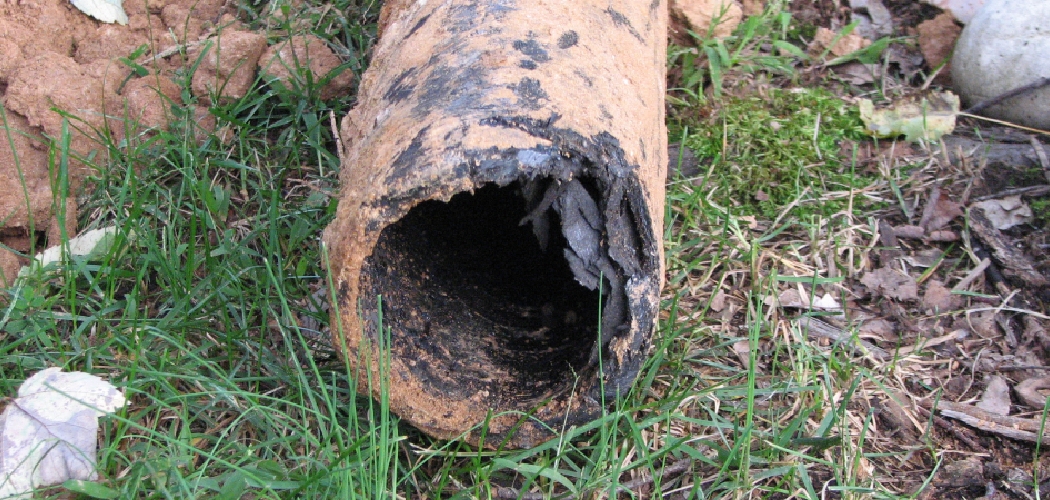Orangeburg pipe, also known as bituminous fiber pipe or sewer pipe, was a popular choice for underground plumbing in the mid-20th century. Made from layers of wood pulp and coal tar pitch, it was lightweight, inexpensive, and easy to install.
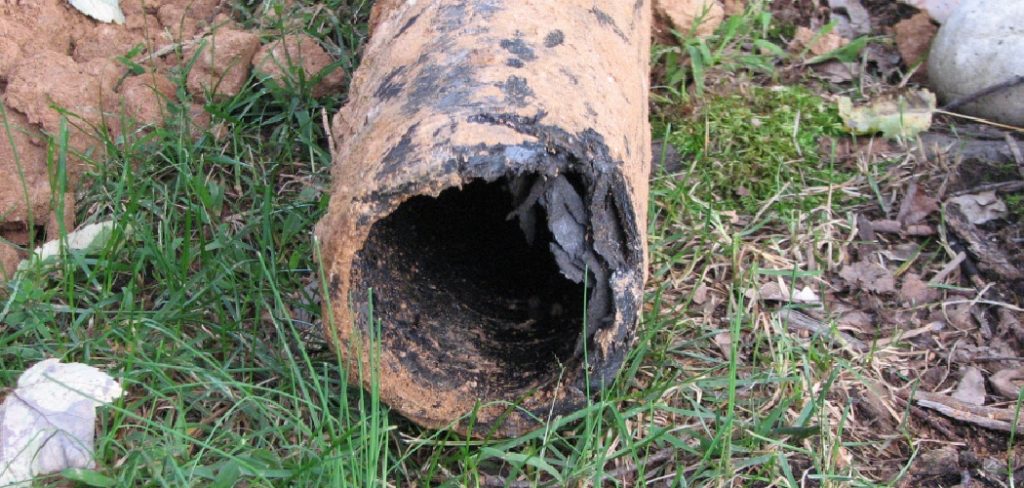
However, over time, Orangeburg pipe can become deformed or collapse due to its composition and exposure to moisture. If you suspect your home may have Orangeburg pipe, it is important to identify and replace it before it causes costly damage. In this guide, we will discuss how to identify Orangeburg pipe and what steps you can take if you find it in your plumbing system.
Necessary Items
Before you start the process of identifying the Orangeburg pipe, there are a few items you will need to gather:
- Protective gear: It is important to wear gloves and a mask while handling any type of plumbing materials. This is especially true for older pipes that may contain harmful chemicals or debris.
- Flashlight: A flashlight will help you see inside your plumbing system and determine if there are any bends or deformities in the Orangeburg pipe.
- Tape measure: You will need to take measurements of the diameter and thickness of the pipe to accurately identify it as Orangeburg.
- Camera or phone: Taking pictures of the pipe can be helpful for later reference or if you need to consult with a professional plumber.
8 Things to Know Before You Start
1) Where to Find?
If your home was built during this time period, there is a higher chance that it may contain Orangeburg pipe. However, it is not uncommon for houses built before or after this time frame to also have Orangeburg pipes. Orangeburg pipe was predominantly used for sewer lines, so it can typically be found underground and connected to your home’s main sewer line. You may also find it leading to a septic tank or drain field.
2) Age
Orangeburg pipe was most commonly used from the mid-1940s to the late 1960s. However, its use continued through the 1970s in some areas. If your home was built during this time frame, there is a higher chance that it contains Orangeburg pipes.
3) Length
Orangeburg pipe typically came in lengths of 2 to 4 feet and was connected with rubber couplings or tar seals. If you find multiple sections of pipe joined together with these materials, it could be a sign that you have Orangeburg pipe.
4) Diameter and Thickness
Orangeburg pipe has an average diameter of 4 inches but can range from 2 to 8 inches. It is also relatively thin compared to other types of pipes, with a thickness of only approximately ⅛ inch. As mentioned earlier, taking measurements of the pipe’s diameter and thickness can help you accurately identify it.
5) Shape

Orangeburg pipe is typically round in shape. However, if it has become deformed or collapsed, it may appear flattened or oval-shaped. While other types of pipes can also become deformed, the composition of Orangeburg pipe makes it more susceptible to warping.
6) Color
The name “Orangeburg” comes from the bright orange color that was used to coat the exterior of the pipe. However, over time, this coating may have worn off or faded, making it harder to identify by color alone.
7) Sound
If you suspect that your home may have an Orangeburg pipe, you can also listen for a distinct sound when running water through it. Due to its composition, Orangeburg pipe has a distinctive hollow sound compared to other types of pipes.
8) Professional Inspection
If you are unsure or unable to accurately identify Orangeburg pipe on your own, it is always best to consult with a professional plumber. They can use specialized tools and techniques to determine the type of pipe in your plumbing system.
12 Steps on How to Identify Orangeburg Pipe
Step 1: Locate the Main Sewer Line
The first step is to locate your home’s main sewer line. This is typically found in a basement or crawl space but can also be located outside near the foundation. And if you are unable to locate it, a professional plumber can help.
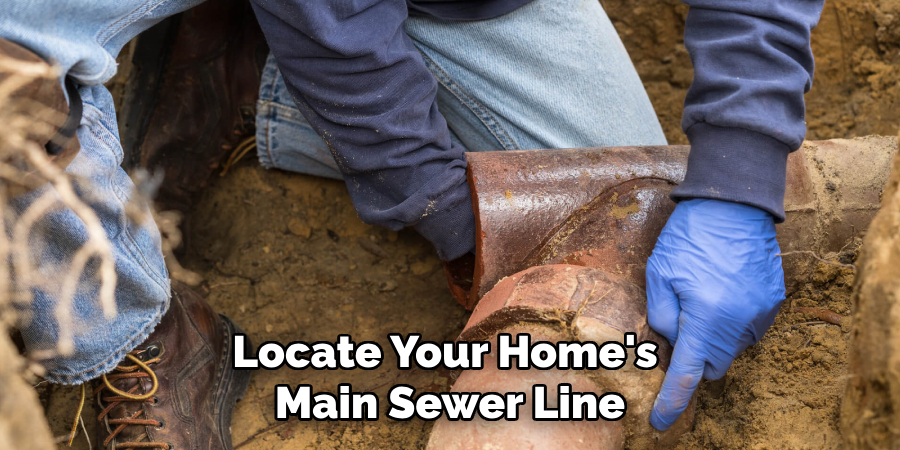
Step 2: Check for Orangeburg Pipe Markings
Some Orangeburg pipes may have stamped markings on the exterior that indicate their manufacturer and date of production. It is important to note that not all Orangeburg pipes will have these markings, so don’t rely on this as your only method of identification.
Step 3: Inspect the Pipe’s Diameter
As mentioned earlier, Orangeburg pipe typically has a diameter of 4 inches. Use a tape measure to confirm the size of the pipe. So, if you find a pipe that is 4 inches in diameter, this could be an indication that it is Orangeburg.
Step 4: Measure the Thickness
Using a tape measure or caliper, determine the thickness of the pipe. As noted earlier, Orangeburg pipe has a relatively thin thickness of approximately ⅛ inch. If the pipe’s thickness is significantly thinner than other pipes in your plumbing system, it could be Orangeburg.
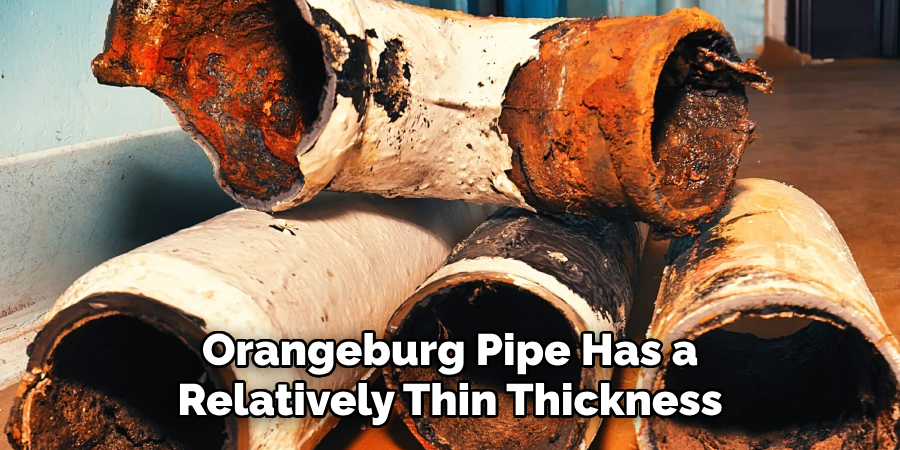
Step 5: Check for Deterioration
Over time, Orangeburg pipe can deteriorate and become brittle. Use a flashlight to inspect the exterior of the pipe for any cracks or signs of damage. This could indicate that it is nearing the end of its lifespan and may need to be replaced.
Step 6: Look for Deformities
Orangeburg pipe can easily become deformed due to its composition and age. Use a flashlight to check for any bends or flattening in the pipe, which could indicate that it is Orangeburg. While other types of pipes can also become deformed, the composition of Orangeburg pipe makes it more susceptible to warping.
Step 7: Check for Circular Rings
If you can access a section of your pipe, look for circular rings on the interior. Orangeburg pipe is made up of layers of compressed wood fibers, and these rings may be visible when cut open. This is a clear indication that you have Orangeburg pipe in your plumbing system.
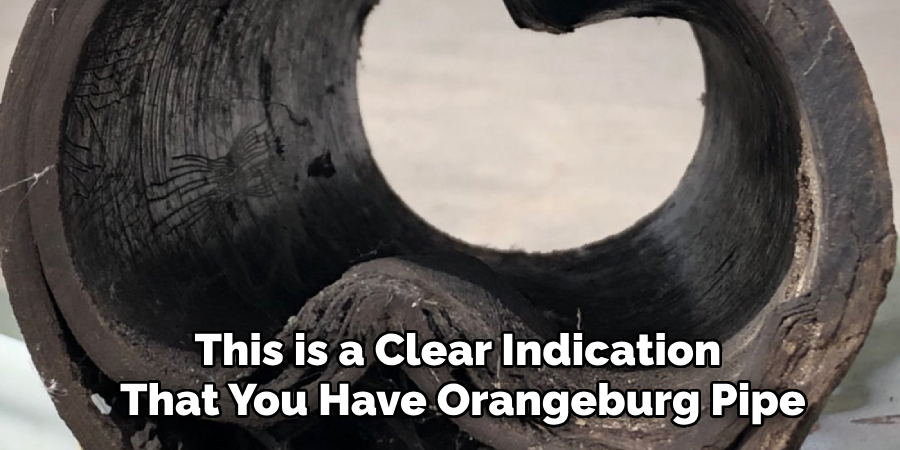
Step 8: Listen for a Hollow Sound
As mentioned earlier, the Orangeburg pipe has a distinct hollow sound when running water is through it. If you suspect that your home may have this type of pipe, try flushing toilets or running faucets to listen for this distinct sound.
Step 9: Identify the Color
As stated before, Orangeburg pipe is typically bright orange in color. However, over time, this coating may have worn off or faded, making it difficult to identify by color alone. If you are unable to see a distinct orange hue on the exterior of the pipe, use other identification methods.
Step 10: Consult a Professional
If you are unsure or unable to accurately identify Orangeburg pipe on your own, it is best to consult with a professional plumber. They have the knowledge and tools to properly identify the type of pipe in your plumbing system.

Step 11: Consider the Age of Home
Orangeburg pipe was most commonly used from the mid-1940s to the late 1970s. If your home was built during this time period, there is a higher likelihood that you may have Orangeburg pipe in your plumbing system.
Step 12: Consider Other Factors
While these steps can help you identify the Orangeburg pipe, it is important to consider other factors as well. For example, if your home has a septic system, it is less likely to have Orangeburg pipe in its plumbing system. Additionally, the type of material used for other plumbing components (such as joints and fittings) can also help identify the type of pipe in your home. Overall, it is important to use multiple methods to accurately identify the Orangeburg pipe and consult with a professional if needed for confirmation.
By following these 12 steps on how to identify Orangeburg pipe and considering other factors, you can confidently identify Orangeburg pipe and take the necessary steps to replace it for the safety and maintenance of your home. Remember, when in doubt, always consult with a professional plumber for assistance.
8 Things to Avoid when Dealing with Orangeburg Pipe
While it is important to actively identify and replace Orangeburg pipe in your plumbing system, there are also certain things that should be avoided when dealing with this type of material. These include:
1) Ignoring Visible Signs
If you notice any signs of deterioration or deformities on your pipes, do not ignore them. This could lead to potential damage to your plumbing system and home. As soon as you suspect that you may have Orangeburg pipe, take action to identify and replace it.
2) Attempting to Replace on Your Own
Replacing the Orangeburg pipe requires specialized tools and knowledge. It is best to leave this task to a professional plumber who can ensure safe and proper installation. Attempting to replace the pipe on your own could result in further damage and costly repairs.
3) Waiting too Long to Replace
As mentioned earlier, Orangeburg pipe has a limited lifespan and can become brittle over time. Waiting too long to replace it could result in serious damage to your plumbing system and possibly even cause health hazards due to potential leaks or contamination.
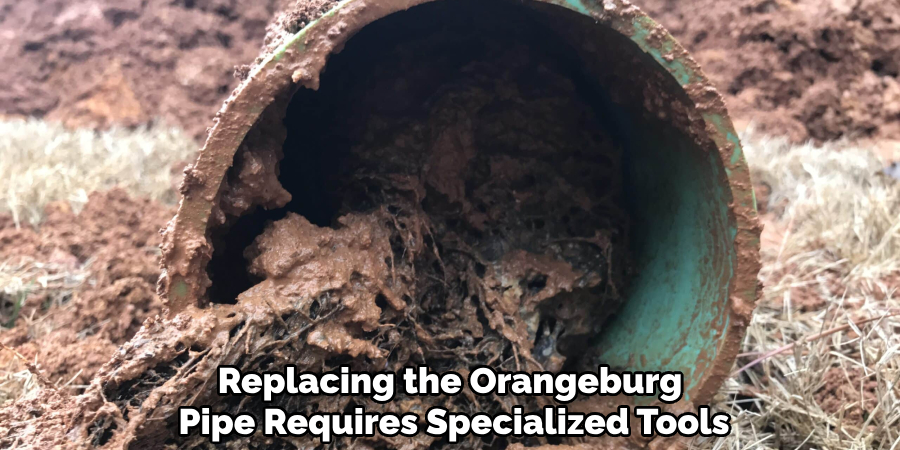
4) Not Considering Other Factors
While identifying Orangeburg pipe may seem straightforward, there are other factors that should be considered. As mentioned before, the age of your home and the type of plumbing components used can also impact the likelihood of having Orangeburg pipe in your system.
5) Neglecting Maintenance
Regular maintenance and inspections of your plumbing system can help catch any issues with Orangeburg pipe early on. This can save you from costly repairs and potential damage to your home. But neglecting maintenance can lead to bigger problems in the long run.
6) Not Seeking Professional Help
As with any plumbing issue, it is important to seek professional help when dealing with Orangeburg pipe. They have the expertise and experience to properly identify and replace the pipe, ensuring the safety and functionality of your plumbing system.
7) Disposing of Old Pipe Improperly
If you do decide to replace the Orangeburg pipe in your home, make sure to dispose of it properly. Due to its composition, it cannot be recycled and should not be disposed of with regular household waste. Contact your local waste management department for proper disposal methods.
8) Ignoring Health Risks
Orangeburg pipe has been known to cause health hazards due to potential leaks and contamination. If you suspect that your home has this type of pipe, take immediate action to replace it for the safety of you and your family.By avoiding these eight things, you can ensure a smooth and safe process when dealing with Orangeburg pipe in your plumbing system.
Remember, proper identification and replacement are crucial for the functionality and maintenance of your home. So, take the necessary steps to address any issues with the Orangeburg pipe and seek professional help when needed. Don’t wait until it’s too late! Take action now for a healthier plumbing system and home. Remember, prevention is always better than cure. Keep these tips in mind and stay proactive when dealing with Orangeburg pipe.

8 Additional Tips for Maintaining Your Plumbing System
While addressing the Orangeburg pipe in your plumbing system is important, it is just as crucial to properly maintain your entire system. Here are eight additional tips to help keep your plumbing running smoothly:
1) Regularly Inspect and Clean Drains
To prevent clogs and buildup, regularly inspect and clean all drains in your home. This includes sinks, showers, and toilets. Use a plunger or a drain snake to remove any blockages. But if the problem persists, seek professional help.
2) Be Mindful of What Goes Down the Drain
Avoid flushing or rinsing down items such as grease, oils, and food scraps. These can cause clogs and damage to your pipes over time. Use a compost bin for food waste and dispose of grease and oil in a separate container.
3) Check for Leakages
Periodically check all visible pipes and fixtures for any signs of leaks. If you notice any, address them immediately to prevent further damage and conserve water. If left untreated, leaks can lead to mold growth and costly repairs.

4) Test Water Pressure
Low water pressure could indicate a problem with your plumbing system. Check the water pressure regularly, and if it seems low, contact a professional plumber to identify and fix the issue. However, if the pressure is too high, consider installing a pressure-reducing valve.
5) Insulate Exposed Pipes
In colder climates, exposed pipes are at risk of freezing and bursting. Insulating them can prevent this from happening and save you from costly repairs. You can purchase foam insulation tubes or even use towels and duct tape as a temporary solution.
6) Know the Location of Your Main Shutoff Valve
In case of an emergency, it is important to know where your main shutoff valve is located. This will allow you to quickly turn off the water supply to your home and prevent further damage in case of a burst pipe or major leak.
7) Schedule Regular Maintenance with a Professional
Just like any other system in your home, your plumbing system needs regular maintenance. Schedule annual check-ups with a professional plumber to catch any potential issues early on and keep your plumbing running smoothly.
8) Educate Yourself
Knowing the basics of how your plumbing system works can help you identify potential issues and understand when it’s time to seek professional help. Educate yourself through online resources or attend workshops and classes offered by local plumbing companies.
Remember, a well-maintained plumbing system can save you from costly repairs and ensure the safety of your home. So make sure to take proper care of it and seek professional help when needed. With these tips in mind, you can keep your plumbing system functioning properly for years to come. Don’t wait until it’s too late. Start taking care of your plumbing system today!
And be proactive in identifying and addressing any potential issues. Your home and family will thank you for it. So take the necessary steps on how to identify Orangeburg pipe to maintain a healthy plumbing system and avoid common pitfalls like Orangeburg pipe. Stay informed, stay aware, and stay ahead of any plumbing issues that may arise.
Frequently Asked Questions
Here are some frequently asked questions about Orangeburg pipe and plumbing maintenance:
What is Orangeburg Pipe?
Orangeburg pipe is a type of sewer line made from a tar-like material that was commonly used in residential plumbing systems until the 1970s. It has since been found to have several issues, including its short lifespan and susceptibility to damage.
How Can I Tell if My Home Has Orangeburg Pipe?
If your home was built before the 1970s, there is a chance that it may have Orangeburg pipe in its plumbing system. You can confirm this by consulting with a professional plumber or conducting a visual inspection of your pipes.
Is It Safe to Use Orangeburg Pipe for Landscaping?
No, Orangeburg pipe should not be used for landscaping purposes as it can still pose health and environmental risks. It is best to dispose of any leftover Orangeburg pipe properly through your local waste management department.
Can I Replace Orangeburg Pipe Myself?
Replacing the Orangeburg pipe requires specialized knowledge and equipment, so it is recommended to seek professional help. Attempting to replace it yourself could lead to further damage and costly repairs.
How Often Should I Schedule Maintenance for My Plumbing System?
It is recommended to schedule annual check-ups with a professional plumber to ensure the proper functioning of your plumbing system. However, if you notice any issues, such as leaks or clogs, seek help immediately. Prevention is key to maintaining a healthy plumbing system. So be proactive, stay informed, and take care of your plumbing system for a hassle-free home.
Conclusion
Maintaining your plumbing system is essential for a healthy and functioning home. Be sure to address any issues with Orangeburg pipe, as well as follow these additional tips on how to identify Orangeburg pipe to keep your plumbing system in top shape.
Remember, prevention is always better than cure when it comes to plumbing problems. Stay proactive, educate yourself, and seek professional help when needed to ensure the longevity of your plumbing system for years to come.
So keep these tips in mind and enjoy a hassle-free home with smoothly-running plumbing! Keep the water flowing, keep your home clean and safe, and never neglect the health of your plumbing system. By following these tips, you can save yourself from costly repairs and potential disasters in the future.

